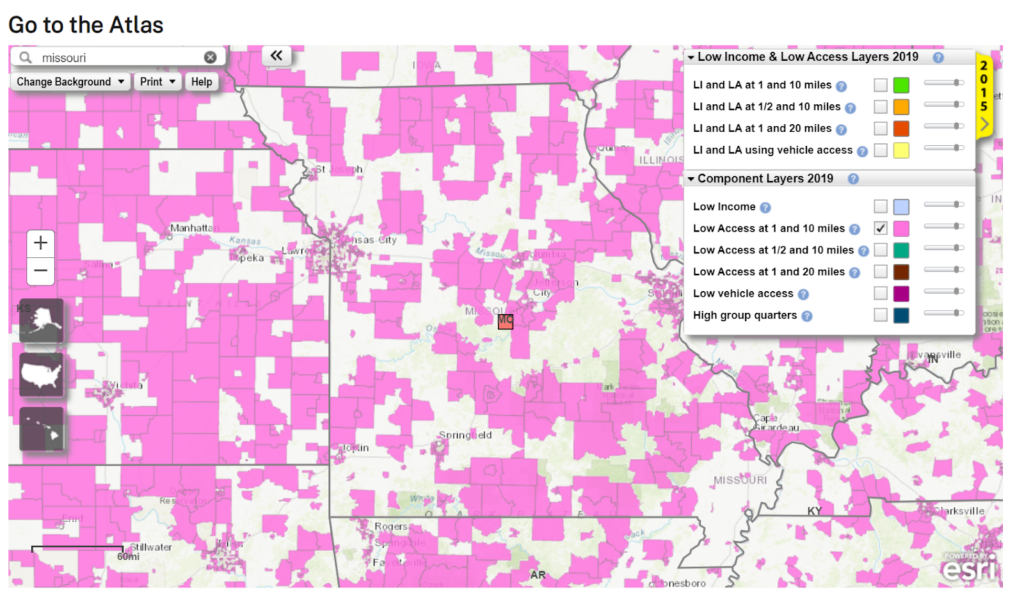Food is one of a handful of basic requirements for our survival. Yet too many Missourians are unable to meet this basic need when faced with the barriers of affordability and accessibility. According to 2022 data analyzed by Feeding America, 15 percent of Missourians – more than 920,000 people are food insecure. The numbers are even more dire when we focus specifically on children: one in five Missouri children experiences food insecurity. More than 250,000 children in our state deal with the very adult responsibility of worrying about whether they will have enough food to eat.
As a country, we’ve created an array of programs to help address the issue of food insecurity. Most of us are familiar with at least a few of the federal nutrition programs created over the past 85 years to bolster the nutrition of specific populations, including pregnant and postpartum women, infants and children, people with disabilities, and senior citizens. The largest of these programs provide a direct monthly benefit to eligible participants, redeemable on eligible purchases at participating retail stores, as with the Supplemental Nutrition Assistance Program (SNAP) or the Special Supplemental Nutrition Program for Women, Infants, and Children (WIC). In 2022, SNAP recipients in Missouri received $1.3 billion in benefits at an average of $185 per household member per month.
If the federal nutrition programs have been around for decades, why are so many Missourians still struggling with food insecurity? The federal nutrition programs address the affordability of food for low-income households, however, these programs do not address the issue of accessibility. Many Missouri residents live more than one mile in urban areas, and ten miles in rural areas, from a grocery store, the current benchmarks for “low access.” The USDA provides a mapping tool, the Food Access Research Atlas, which can be used to visualize areas of low access, and other characteristics that impact food accessibility, such as low vehicle access and areas of concentrated poverty.

In the past 20 years, we’ve begun to see efforts at the local, state, and federal levels to address the issue of food accessibility through policy, systems and environmental change (PSE). These efforts are often known as Healthy Food Financing Initiatives (HFFIs). HFFIs typically provide non-traditional financing options and expert technical assistance to food retail projects (like traditional brick and mortar grocery stores) and food enterprise projects (such as mobile markets or food hubs) that will introduce or improve healthy food access in areas that lack access.
Introduced in 2004, the Pennsylvania Fresh Food Financing Initiative (FFFI) was the first HFFI program in the nation. The FFFI was a collaborative effort of state government, non-profit organizations, and a community development financial institution (CDFI). The FFFI was seeded with a total of $30 million in state funding over the first three years of operation, which was combined with $145 million in additional public and private funding. The initiative provided project funding in the form of loans ranging from $200,000 to $3.5 million, as well as grants of up to $250,000 per project. The FFFI financed a total of 88 projects over a six-year period. These projects resulted in 5,000 jobs and the development of more than 1.67 million square feet of food retail, bringing healthy food access to an additional 400,000 people. The success of the FFFI spurred the development of projects in several localities and states, as well as driving the development of the federally-funded America’s Healthy Food Financing Initiative.
America’s Healthy Food Financing Initiative came into existence with the 2014 Farm Bill. The program is administered by Reinvestment Fund, the CDFI partner of the Pennsylvania FFFI. America’s HFFI has awarded more than $25 million in direct funding to food retail and food enterprise projects in 48 states, Washington D.C. and Puerto Rico. Most recently, America’s HFFI awarded $40 million in funding to 16 public-private partnerships through the Local and Regional Healthy Food Financing Partnerships Program. The purpose of the HFFI Partnerships Program is to support the development of HFFIs in localities, states, and tribal communities throughout the country.
Empower Missouri partnered with University of Missouri Extension, IFF, y Missouri Coalition for the Environment to apply for the HFFI Partnership Program funding, and was awarded a three-year, $1 million capacity building grant. This amazing grant opportunity allowed us to form the Missouri Rural Food Access Partnership. We are focused on achieving two major outcomes during the HFFI Partnership Program grant. First, University of Missouri Extension will work with eligible rural communities to implement the Missouri EATs program to surface and develop a pipeline of fundable food retail and food enterprise projects in rural areas of low food access.
At the same time, we will work to build a strong statewide coalition of stakeholders who are interested in contributing to the development and funding of a statewide HFFI for Missouri. The list of potential stakeholders includes our partners in urban areas who are engaged in HFFI work, CDFIs and other lending institutions that want to contribute to the development of a statewide HFFI lending network, organizations working with impacted populations and geographies throughout the state, and healthcare institutions focused on long-term sustainable solutions to healthy food access through policy, systems and environmental changes.
July marks the start of our three-year grant. We are eager to share more about our initial plans for the Missouri Rural Food Access Partnership, gather input from the community, and on-board new partners interested in taking an active role in this work. We hope that you will join us for a one-hour webinar on Wednesday, July 24th, 10 – 11 a.m., to learn more about the Partnership and how you can be involved. Use este enlace to register; and while we hope you will join us live and contribute to the conversation, everyone who registers will receive a link to the recorded webinar.
